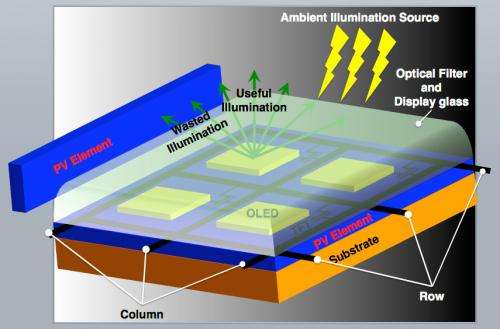January 22, 2012 report
Cambridge team uses solar cells in OLED screen to power smartphones

(PhysOrg.com) -- With the world's showroom floors crammed with prototype smartphones promising advanced functions, bigger displays, stunning resolution, wouldn’t you think the biggest crowd-pleasers would dominate? The ultimate attraction in a smartphone, the one that never has to be charged again? This ultimate solution at least has scientists working toward that end, to bring in an easier time where users will not need to worry about the batteries wearing out.
A team of researchers at the University of Cambridge are getting closer. Their idea is to harvest energy from wasted light in an OLED display. They are working on technology where users will not need to plug in their smartphones for recharging at least as often. In their project, an OLED screen uses solar cells to absorb scattered and wasted light, sending it back into the screen.
IEEE Fellow Arokia Nathan along with the Cambridge team have developed a prototype device that converts ambient light into electricity. Solar cells used in the prototype are made of thin film hydrogenated amorphous silicon, within the smartphone screen.
Only around 36 percent of the light produced by an OLED display is projected forwards; the rest escapes around the edges, in the form of scatter and bleeding from the edges. The researchers worked on a solution where they could harvest what’s lost by installing photovoltaic cells on the back and sides of OLED screens to capture the loss.
They also worked out a solution—a thin-film transistor circuit--to even out the voltage spikes produced by the solar cells, as fluctuations in the voltage provided by the solar cell could damage the phone’s battery. The device captures both ambient light and the otherwise wasted screen light leaking around the edges.
According to reports, the team worked with the energy group at Cambridge's Centre for Advanced Photonics and Electronics to integrate a thin-film supercapacitor for intermediate energy storage.
The end result is a system that makes use of photovoltaics, transistors, and supercapacitor. The system would achieve an efficiency of 11 percent and peak efficiency, 18 percent.
The numbers, for the smartphone user, would promise at least less strain on their battery. The Cambridge team’s effort is not promising “never-again” recharging but an ability for the user to save a fraction of power.
More work is ahead. The team is exploring different circuit designs and materials with the aim of increasing the energy harvesting system’s efficiency. Nathan has said other energy scavenging schemes such as MEMS based kinetic energy harvesting may bring improvements.
More information:
via IEEE
© 2011 PhysOrg.com




















